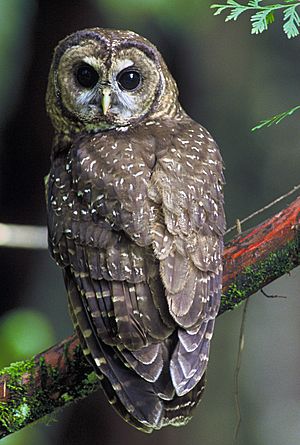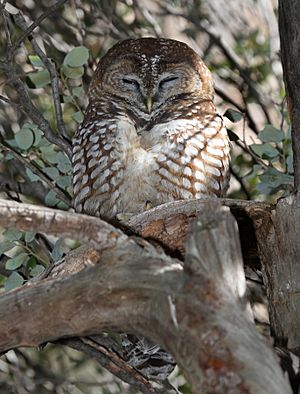Spotted owl facts for kids
Quick facts for kids Spotted owl |
|
|---|---|
 |
|
| Northern subspecies | |
| Conservation status | |
| Scientific classification | |
| Genus: |
Strix
|
| Species: |
occidentalis
|
| Subspecies | |
|
3, see text |
|
 |
|
The spotted owl (Strix occidentalis) is a type of true owl. It lives in the old, tall forests of western North America. These owls make their homes in tree hollows, old nests built by other birds, or cracks in rocks.
Their nests can be very high up, from about 12 to 60 meters (about 40 to 200 feet) off the ground. Most nests have two eggs, but sometimes they can have up to four. Spotted owls are active at night and hunt small mammals and birds. There are three different types, or subspecies, of spotted owls. They live in areas from British Columbia in Canada all the way down to Mexico. The spotted owl is losing its forest home, which means it is a near-threatened species.
Contents
What Does a Spotted Owl Look Like?
A spotted owl is about 43 centimeters (17 inches) long. Its wings can spread out to about 114 centimeters (45 inches). It weighs around 600 grams (1.3 pounds). Their eggs are white and smooth, a little over 50 millimeters (2 inches) long.
Spotted owls look a lot like barred owls. But spotted owls have X-shaped marks on their chests and bellies. Barred owls have stripes on their chests and streaks on their bellies. Barred owls are also bigger and grayer.
In recent years, barred owls have been moving into areas where spotted owls live. Barred owls are more aggressive and eat more types of food. They can also live in more different kinds of places. Even though these two owl types are very different genetically, they sometimes breed together. This creates a mixed owl called a "sparred owl."
Spotted Owl Subspecies
There are three recognized types of spotted owls:
- S. o. caurina – known as the northern spotted owl.
- S. o. lucida – known as the Mexican spotted owl.
- S. o. occidentalis – known as the California spotted owl.
The Gila Wilderness in the United States is home to the largest group of Mexican spotted owls.
Where Do Spotted Owls Live?
The northern spotted owl lives in a long, connected area. This stretches from southwestern British Columbia in Canada. It goes south through western Washington and Oregon states. It reaches down to Marin County, California.
The California spotted owl lives in areas that overlap with the northern type. Its range starts in the southern Cascade Range. It goes south through the western Sierra Nevada mountains to Tulare County, California. There are also separate groups in the mountains along the coast and in southern California. These range from Monterey County to northern Baja California in Mexico.
The Mexican spotted owl lives in separate groups in mountains and canyons. These are found in Utah, Colorado, Arizona, New Mexico, and western Texas in the US. In Mexico, they live in Sonora, Chihuahua, Nuevo León, and eastern Coahuila. They are found in the Sierra Madre Occidental and the Sierra Madre Oriental mountain ranges.
Spotted Owl Habitat
Spotted owls live in different kinds of forests. These include both hardwood and pine forests. They especially like forests with a thick overhead cover of trees. They prefer older forests with trees of different ages.
The Mexican spotted owl can also live in chaparral areas and pinyon woodlands. This includes deep, steep canyons with little tree cover. The California spotted owl uses forests that have been affected by wildfire for hunting. They seem to do well in areas with more severe fires.
Large trees are important for all three types of spotted owls. They use these trees for nesting and for resting during the day. They usually look for places where more than 40% of the sky is covered by tree leaves. Often, it's even more than 70% covered. A lot of tall bushes are also common in spotted owl homes.
Northern spotted owls can be found from about 70 to 6,600 feet (21 to 2,012 meters) high. California spotted owls live from about 1,000 to 8,500 feet (305 to 2,591 meters) high. Mexican spotted owls live at even higher elevations, from about 6,000 to 8,500 feet (1,829 to 2,591 meters). All spotted owls seem to like living near water.
Spotted Owl Ecology
Home Range and Density
Spotted owls need large areas to live and hunt. The size of their home range changes. It depends on the type of owl, the habitat, and how much food is available. These ranges can be from about 661 to 14,169 acres (2.7 to 57.3 square kilometers).
Their home ranges are smaller during the breeding season. Female owls usually have larger home ranges than males. The number of spotted owl pairs in an area also depends on the quality of the habitat.
Nesting Habits
Spotted owls do not build their own nests. Instead, they use holes in trees, dead wood, or standing dead trees. They also use old nests that raptors or squirrels have left behind. Some nest sites are used again and again.
Good breeding spots that are used regularly stay occupied even after wildfires. But less good spots are more likely to be left after a fire. Spotted owls often choose the same kind of tree cover for nesting as they do for resting during the day.
Reproduction and Life Cycle
The spotted owl's breeding season starts in early spring and lasts until late summer or fall. They begin getting ready to breed in February or March. This includes preening and resting together.
Spotted owl pairs are monogamous, meaning they stay with one partner. They rarely try to nest again if their first attempt fails. These owls do not usually breed every year. On average, they breed about 62% of the time. Young owls can start breeding at one year old, but it's more common for them to be two years or older.
They usually lay two eggs, but sometimes they can lay up to four. The female owl sits on the eggs and takes care of the young. The male owl brings food for them. Eggs hatch after about a month. Young owls leave the nest (fledge) and become independent after three to four months. Once they are independent, young owls move to new areas in late summer or fall. They often find a place to spend the winter before looking for their own breeding areas in the spring. They usually move less than 19 miles (30 kilometers) away.
Lifespan and Dangers
Spotted owls can live a long time. Some northern spotted owls have been known to live for 16 or 17 years. Adult owls usually survive more than 80% of the time each year. But young owls have a much lower survival rate, around 21-29%. In New Mexico, only about 11% of young Mexican spotted owls survive after leaving the nest.
The most common reasons for owls to die are being hunted by other animals, not finding enough food, and sometimes disease. Many animals hunt spotted owl eggs and young. These include the fisher (a type of mammal) and crows. Northern goshawks and crows may hunt young owls. Larger birds like great horned owls, red-tailed hawks, and golden eagles can hunt both young and adult owls.
Great horned owls and barred owls may also compete with spotted owls for food and space. Barred owls can even make it harder for northern spotted owls to survive and have babies in some areas.
What Do Spotted Owls Eat?
Spotted owls are night hunters. They are "sit-and-wait predators." This means they often sit on a perch and wait for prey. Then they swoop down or pounce on their food. They can also grab prey from tree trunks and branches. Sometimes, they even hunt during the day.
What they eat changes depending on where they live. But most of their diet is made up of a few types of mammals. The most common foods are northern flying squirrels (which can be over 30% of their diet). They also eat woodrats, including dusky-footed, bushy-tailed, and Mexican woodrats.
In some areas, spotted owls also eat other mammals. These include deer mice, pocket gophers, voles, snowshoe hares, and different kinds of squirrels. They eat fewer bats and non-mammal prey. This can include smaller birds (like other owls, jays, woodpeckers, and songbirds), amphibians, reptiles, and insects.
Spotted Owl Conservation
The IUCN Red List says the spotted owl is "near threatened." This means its population is decreasing. Many studies show that the number of spotted owls is going down.
Losing their forest homes because of timber harvesting is the main threat. Some studies also say that competition with the barred owl is a big reason for the decline. Forest managers sometimes say that severe wildfires hurt spotted owl populations. But a study found that fires actually helped spotted owls more than they harmed them.
The northern spotted owl and Mexican spotted owl are listed as threatened in the United States. This is under the Endangered Species Act. The California spotted owl is not considered threatened by the U.S. Fish and Wildlife Service. However, the state of California and the United States Forest Service see it as a species of special concern.
The northern spotted owl was part of a special case. A group called the "God committee" had to decide if more federal forest land could be used for logging. This was a conflict between two government groups. The committee decided to allow logging on 1,700 acres. This decision could potentially lead to the extinction of the species in that area. This legal fight became a complex example in environmental law.
All types of spotted owls are often part of disagreements. These happen between conservationists (people who protect nature) and loggers, cattle grazers, and developers. These groups do things that can affect forest conservation. In 2008, a judge supported a decision to protect about 8.6 million acres (35,000 square kilometers) in Arizona, Utah, Colorado, and New Mexico as important habitat for the owl. This decision was challenged by a cattle group but was upheld.
By 2006, the northern spotted owl population was quickly decreasing in the northern part of its range. It was going down by 7.2% each year in northern Washington and southwestern British Columbia. In 2006, fewer than 30 breeding pairs were thought to be left in Canada. Some experts believed the species might soon disappear from Canada completely.
An experiment approved by the USFWS looked at how to protect the spotted owl. They tried controlling the barred owl, which competes with the spotted owl. In 2009, they started removing barred owls from certain areas. The studies found that where barred owls were removed, the spotted owl population did not decline. In fact, they were able to recover.
![]() This article incorporates public domain material from the United States Department of Agriculture document "Strix occidentalis".
This article incorporates public domain material from the United States Department of Agriculture document "Strix occidentalis".
See also
 In Spanish: Cárabo Californiano para niños
In Spanish: Cárabo Californiano para niños



